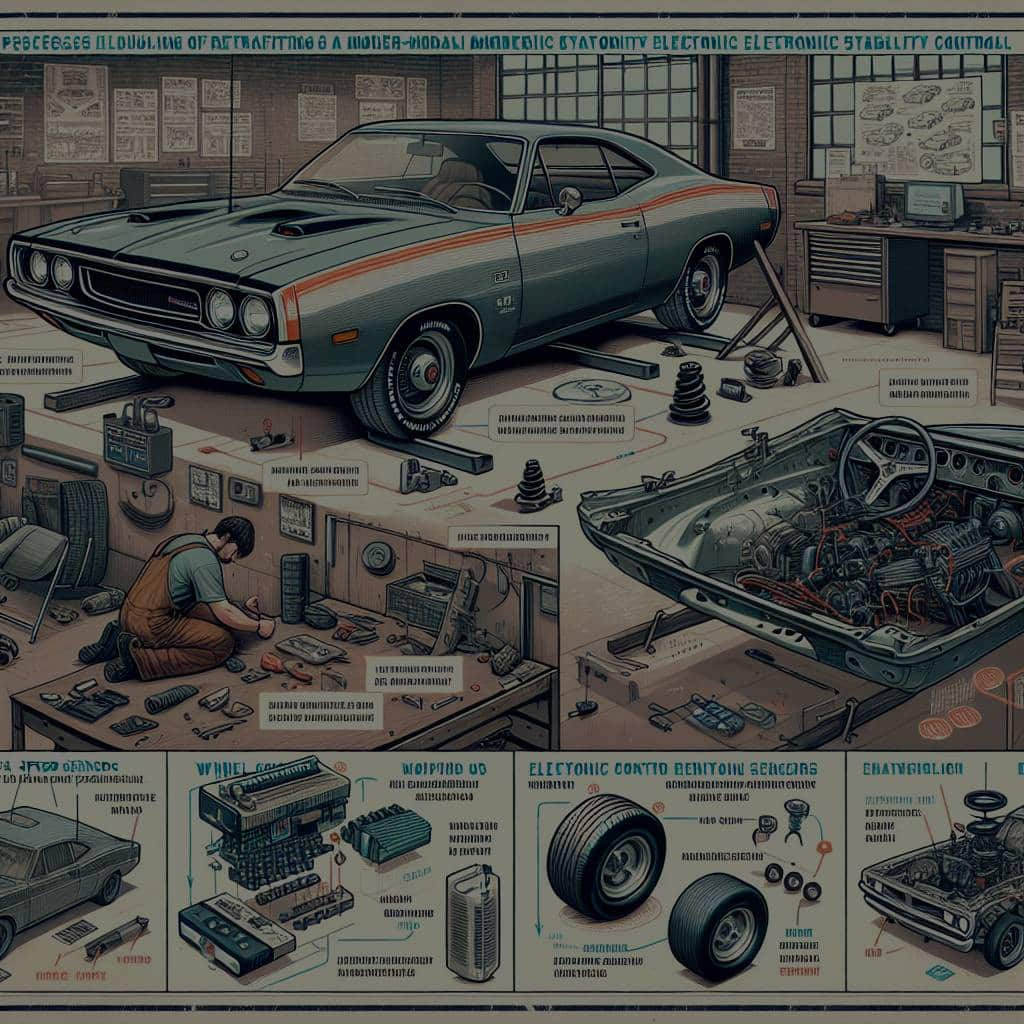The charm of classic muscle cars is irresistible. The raw power, the thunderous roar of the engine, the sheer machismo that emanates from every pore of these automotive beasts. However, like most things from the yesteryears, classic muscle cars fall short on one crucial aspect – safety. Modern cars come equipped with numerous safety components, one of them being the Electronic Stability Control (ESC). This modern marvel of automotive technology significantly improves a vehicle’s safety, reducing the risk of fatal single-vehicle crashes by over 50%. This article will guide you on how to retrofit modern Electronic Stability Control in classic muscle cars.
Understanding the Importance of Electronic Stability Control
Before we delve into the retrofitting process, you must understand what ESC is and why it is essential. ESC is a modern automotive safety component that monitors the car’s direction of travel and steering wheel position. When it detects significant deviation between the two, it automatically applies brakes to the appropriate wheels to help steer the car back on track. This gives the driver greater control over the vehicle, reducing the risk of skidding or rolling over, especially during sharp turns or slippery conditions.
Additional reading : What Are the Best Performance Mods for a Fiat Abarth 500 Competizione?
Moreover, ESC has been mandatory in all new cars sold in the United States since 2012, underlining its importance for vehicle safety. Despite the modern conveniences and safety measures, the raw power and machismo of a classic muscle car are irreplaceable. Hence, retrofitting your classic muscle car with an ESC system is a great way to bridge the gap between the old and the new.
Selecting the Right ESC System
Not all ESC systems are created equal. Hence, selecting the right one for your vehicle is crucial. When selecting an ESC system, consider factors like the car’s weight, power, driving characteristics, and other specific needs. Generally, aftermarket ESC systems are designed to work with a wide range of vehicles, so you should be able to find one that fits your car.
Also read : Can a Carbon Fiber Driveshaft Improve the Driveline Efficiency in a Nissan 350Z?
Before purchasing an ESC system, check if the supplier offers comprehensive installation instructions and technical support. This will be incredibly useful, especially if you are doing the retrofitting yourself. Additionally, you may want to check if the ESC system comes with any form of insurance, as this could potentially save you a significant amount of money in case of any mishaps.
Preparing Your Classic Muscle Car for ESC Retrofitting
Before you begin retrofitting your car with an ESC system, ensure that your car’s other components are in top shape. The brakes, tires, and suspension system should all be in good condition, as they play a crucial role in how well the ESC system works.
To ensure safety while retrofitting, disconnect the car’s battery. This prevents any electrical accidents while working on the vehicle. Check your classic car thoroughly for any potential issues that could interfere with the installation of the ESC system. This includes checking for any rust or damage in the areas where the ESC components will be installed.
Installing the ESC System
Now it’s time for the heart of the retrofitting process – installing the ESC system. The exact installation process will depend on the ESC system you have and the specifications of your classic car, but there are common steps you will likely follow.
Firstly, install the ESC’s central processing unit, ideally in a location that is easily accessible yet protected from the elements. Connect this unit to the car’s engine control unit (ECU) and the sensors that will be installed on the vehicle’s wheels. These sensors are responsible for detecting when the vehicle is losing control and signaling the ESC unit to intervene.
Then, install the ESC system’s hydraulic modulator in the engine bay. This modulator controls the pressure applied to the brakes when the ESC system intervenes. Finally, connect the ESC system to the car’s power source and the brake system.
Once you’ve finished the installation, it’s time to test the system. Start slow, in a controlled environment, to ensure that the ESC system is working as expected. The system should intervene when the vehicle is about to lose control, applying the brakes to the appropriate wheels to stabilize the vehicle.
Ensuring Post-Installation Care
Retrofitting a classic vehicle with modern components can be a complex task that may come with occasional hiccups. Post-installation, you may need to adjust the ESC settings to ensure optimal performance. Monitor the system regularly, especially during the initial days after the installation. This allows you to spot any potential issues early and address them immediately.
Depending on the usage and the make of your car, regular servicing and maintenance of the ESC system will be necessary. Many suppliers offer maintenance packages that can help keep your ESC system in top shape.
In addition, it may be beneficial to get an extended warranty or insurance for your newly installed ESC system. This is a protective measure against any unforeseen circumstances that may lead to costly repairs or part replacements.
Retrofitting your classic muscle car with a modern ESC system is a smart move that brings together the best of both worlds – the power and style of the classic car, and the safety and control provided by modern technology. With careful selection, preparation, installation, and post-installation care, you can equip your classic muscle car with a safety feature that not only elevates its performance but also makes your driving experience more secure and enjoyable.
Cultivating a Safe Driving Experience
Creating a safer driving experience while preserving the authentic charm of a classic muscle car is a goal many auto enthusiasts share. Although many might argue that the visceral experience of driving classic cars is part of the appeal, the addition of modern safety features such as ESC can greatly enhance the overall driving experience.
An essential aspect of ESC is its traction control capabilities. By continuously monitoring the speed of the wheels, the system can detect if one is spinning faster than the others, indicating a loss of traction. When this happens, the ESC system can apply the brakes to the spinning wheel or reduce engine power to help regain traction. This makes it particularly useful in slippery conditions or during hard cornering.
While retrofitting classic muscle cars with modern ESC systems might seem complex, it is an achievable goal for many car enthusiasts. It requires some research, careful planning, and a bit of patience but the reward is well worth the effort. It is important to remember that ESC is not a substitute for safe driving habits or maintaining your vehicle properly. Regular oil changes, brake checks, and other routine maintenance are still needed to keep your classic car running smoothly and safely.
Adding an ESC system to your classic muscle car not only increases its safety and controllability but can also potentially reduce your auto insurance premiums. Many insurance companies offer discounts for vehicles equipped with safety features like ESC. Therefore, the cost of retrofitting could be offset by the savings in your car insurance.
In Conclusion: Embracing Modernity While Preserving Classic Appeal
In the world of auto enthusiasts, there is often a debate about the merits of modern cars versus older cars. While classic muscle cars boast an undeniable charisma and raw power, modern cars are equipped with advanced safety features and conveniences that make them more comfortable and safer to drive.
Retrofitting your classic muscle car with a modern ESC system is an excellent way to enjoy the best of both worlds. You can retain the high performance and nostalgic appeal of your classic car while significantly enhancing its safety profile.
Remember, the presence of ESC won’t alter the personality of your muscle car. Instead, it will add a layer of protection that allows you to fully enjoy the thrill of driving your classic vehicle without compromising safety. Moreover, it might even increase the car’s value, as safety features are often highly sought after in the classic car market.
In conclusion, retrofitting a classic muscle car with a modern ESC system is a thoughtful, practical way to preserve these automotive treasures for future generations. After all, classic muscle cars are more than just vehicles – they are pieces of history, and with the right care and updates, they can continue to offer an exhilarating driving experience for years to come.











